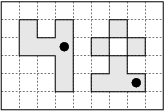
Zadanie Powódź (pow)
Pomóż nam usprawnić bazę zadań!
The Flood
Memory limit: 128 MB
Byteburg, the capital of Byteotia, is a picturesque city situated in a valley in the midst of mountains. Unfortunately, recent heavy rainfall has caused a flood - all the Byteburg is now completely under water. Byteasar, the king of Byteotia, has summoned his most enlightened advisors, including you, to a council. After long deliberations the council agreed to bring a few pumps, set them up in the flooded area and drain Byteburg. The king has asked you to determine the minimum number of pumps sufficing to drain the city.
You are provided with a map of the city and the valley it is situated in. The map is in the shape of a  rectangle, divided into unitary squares. For each such square the map tells its height above sea level and also
whether it is a part of Byteburg or not. The whole area depicted in the map is under water. Furthermore, it is
surrounded by much higher mountains, making the outflow of water impossible. Obviously, there is no need
to drain the area that does not belong to Byteburg.
rectangle, divided into unitary squares. For each such square the map tells its height above sea level and also
whether it is a part of Byteburg or not. The whole area depicted in the map is under water. Furthermore, it is
surrounded by much higher mountains, making the outflow of water impossible. Obviously, there is no need
to drain the area that does not belong to Byteburg.
Each pump can be placed in any unitary square depicted in the map. The pump will be drawing the water until its square is completely drained. Of course, the communicating tubes principle makes its work, so draining one square results in lowering the water level or complete draining of those squares from which the water can flow down to the one with the pump. Water can flow only between squares with a common side (or, more exact, squares whose projections onto horizontal plane have a common side, since the squares may be at different level). Apart from that, the water obviously only flows down.
Task
Write a programme that:
- reads description of the map from the standard input,
- determines the minimum number of pumps needed to drain whole Byteburg,
- writes out the outcome to the standard output.
Input
In the first line of the standard input there are two integers  and
and  , separated by a single space,
, separated by a single space,
 . The following
. The following  lines contain the description of the map. The
lines contain the description of the map. The  'th line
describes the
'th line
describes the  'th row of
unitary squares in the map. It contains
'th row of
unitary squares in the map. It contains  integers
integers  , separated by single spaces,
, separated by single spaces,
 ,
,  .
The number
.
The number  describes the
describes the  'th square of the
'th square of the  'th line. The ground level in this square is
'th line. The ground level in this square is
 above sea level. If
above sea level. If  , then the square is part of Byteburg, otherwise it is outside the city. Notice, that
the area of Byteburg need not be connected. In fact the city may have several separate parts.
, then the square is part of Byteburg, otherwise it is outside the city. Notice, that
the area of Byteburg need not be connected. In fact the city may have several separate parts.
Output
Your programme should write out one integer to the standard output - the minimum number of pumps needed to drain Byteburg.
Example
For the input data:
6 9 -2 -2 -1 -1 -2 -2 -2 -12 -3 -2 1 -1 2 -8 -12 2 -12 -12 -5 3 1 1 -12 4 -6 2 -2 -5 -2 -2 2 -12 -3 4 -3 -1 -5 -6 -2 2 -12 5 6 2 -1 -4 -8 -8 -10 -12 -8 -6 -6 -4
the correct result is:
2

In the figure you can see the area of Byteburg and an exemplary setup of two pumps.
Task author: Marcin Kubica.
Kontakt
In the event of technical difficulties with Szkopuł, please contact us via email at [email protected].
If you would like to talk about tasks, solutions or technical problems, please visit our Discord servers. They are moderated by the community, but members of the support team are also active there.

 English
English